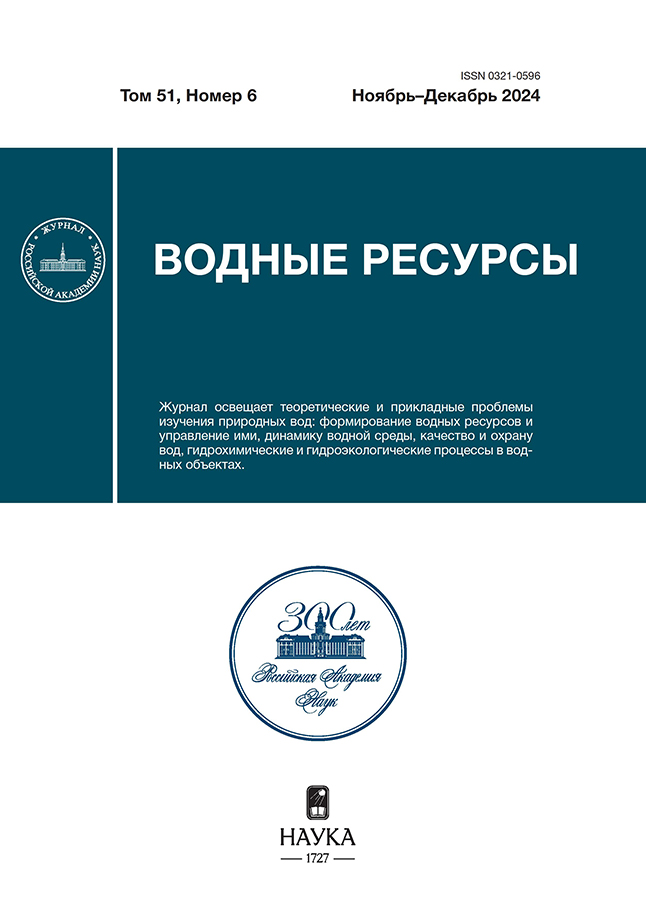Assessment of river runoff components in the Crimean Mountains. 2. Runoff of karst aquifer systems
- 作者: Gubareva T.S.1, Amelichev G.N.1,2, Tokarev S.V.1,2, Vakhrushev B.A.1,2, Gartsman B.I.1,3, Naumenko V.G.2, Amelichev E.G.1,2, Vakhrushev I.B.1,2
-
隶属关系:
- Institute of Water Problems, Russian Academy of Sciences
- Vernadsky Crimean Federal University
- Institute of Natural-Technical Systems
- 期: 卷 51, 编号 6 (2024)
- 页面: 758-774
- 栏目: ГИДРОЛОГИЧЕСКИЕ ПРОБЛЕМЫ ВОДОДЕФИЦИТНЫХ РЕГИОНОВ
- URL: https://journals.eco-vector.com/0321-0596/article/view/684428
- DOI: https://doi.org/10.31857/S0321059624060035
- EDN: https://elibrary.ru/VPPGQC
- ID: 684428
如何引用文章
详细
For experimental basins of karst aquifer systems of Mountainous Crimea, a three-component mixing model has been adapted using geochemical tracers. On its basis, the following stable sources of supply have been established: epikarst water formed mainly in the near-surface fractured and weathered zone of karst rocks; surface-slope water differing in the formation mechanism; base flow water of including a mixture of groundwater from the aeration zones of karst massifs below the epikarst and phreatic zones, providing the base part of the runoff hydrograph. Epikarst waters make up a significant share of the supply in the runoff of karst aquifer systems (> 30%). Close empirical relationships between the shares of the runoff components and the water discharges in the closing sections have been revealed.
全文:
作者简介
T. Gubareva
Institute of Water Problems, Russian Academy of Sciences
编辑信件的主要联系方式.
Email: tgubareva@bk.ru
俄罗斯联邦, Moscow, 119333
G. Amelichev
Institute of Water Problems, Russian Academy of Sciences; Vernadsky Crimean Federal University
Email: tgubareva@bk.ru
俄罗斯联邦, Moscow, 119333; Simferopol, 295007
S. Tokarev
Institute of Water Problems, Russian Academy of Sciences; Vernadsky Crimean Federal University
Email: tgubareva@bk.ru
俄罗斯联邦, Moscow, 119333; Simferopol, 295007
B. Vakhrushev
Institute of Water Problems, Russian Academy of Sciences; Vernadsky Crimean Federal University
Email: tgubareva@bk.ru
俄罗斯联邦, Moscow, 119333; Simferopol, 295007
B. Gartsman
Institute of Water Problems, Russian Academy of Sciences; Institute of Natural-Technical Systems
Email: tgubareva@bk.ru
俄罗斯联邦, Moscow, 119333; Sevastopol, 299011
V. Naumenko
Vernadsky Crimean Federal University
Email: tgubareva@bk.ru
俄罗斯联邦, Simferopol, 295007
Ev. Amelichev
Institute of Water Problems, Russian Academy of Sciences; Vernadsky Crimean Federal University
Email: tgubareva@bk.ru
俄罗斯联邦, Moscow, 119333; Simferopol, 295007
I. Vakhrushev
Institute of Water Problems, Russian Academy of Sciences; Vernadsky Crimean Federal University
Email: tgubareva@bk.ru
俄罗斯联邦, Moscow, 119333; Simferopol, 295007
参考
- Вахрушев Б.А., Вахрушев И.Б. Роль карстовых конденсационных вод в водном хозяйстве античных и средневековых поселений Керченского полу острова // Культура народов Причерноморья. 1999. № 10. C. 7–10.
- Воронков П.П. Закономерности процесса формирования и зональность химического состава вод местного стока // Тр. ГГИ. Л.: Гидрометеоиздат, 1963. Вып. 102. С. 43–119.
- Газда С. Источники загрязнения и охрана карстовых вод Западных Карпат // Тр. Международ. симпоз. по гидрологии карста. Будапешт, 1978. Т. 2. C. 141–155.
- Губарева Т.С., Амеличев Г.Н., Гарцман Б.И., Токарев С.В., Хрусталева Л.И., Морейдо В.М. Ионный состав генетических типов природных вод речных бассейнов Горного Крыма // Вод. ресурсы. 2024. В печати.
- Губарева Т.С., Амеличев Г.Н., Гарцман Б.И., Токарев С.В., Вахрушев Б.А., Науменко В.Г., Амеличев Е.Г., Вахрушев И.Б. Оценка составляющих речного стока Горного Крыма. 1. Сток малых рек // Вод. ресурсы. В печати.
- Дублянский В.Н. Карстовые пещеры и шахты Горного Крыма. Л.: Наука, 1977. 182 с.
- Дублянский В.Н., Дублянский Ю.В. Проблема конденсации в карстоведении и в спелеологии // Пещеры. 2001. Вып. 27–28. С. 51–72.
- Дублянский В.Н., Кикнадзе Т.З. Гидрогеология карста Альпийской складчатой области юга СССР. М.: Наука, 1984. 128 с.
- Климчук А.Б. Эпикарст: гидрогеология, морфогенез и эволюция. Симферополь: Изд-во Сонат, 2009. 111 c.
- Красная пещера. Опыт комплексных карстологических исследований / Под ред. В.Н. Дублянского. М.: Изд-во РУДН, 2002. 190 с.
- Максимович Г.А. Основы карстоведения. Т. 1. Пермь: Пермское кн. изд-во, 1963. 445 с.
- Прокофьев С.С. Роль конденсационной воды в образовании карстовых пещер // Пещеры. 1964. Вып. 4 (5). С. 35–38.
- Токарев С.В. Уязвимость карстовых подземных вод Горного Крыма к загрязнению: выявление, оценка и картирование. Автореф. дис. ... канд. геогр. наук. Симферополь: КФУ, 2020. 26 с.
- Токарев С.В., Амеличев Г.Н., Середа А.И., Брага Е.В. Установление границ подземно-карстовых водосборов в верховьях р. Бельбек (Горный Крым) методом трассерных экспериментов // Пятые Виноградовские чтения. Гидрология в эпоху перемен. СПб.: Изд-во ВВМ, 2023. С. 553–557.
- Шестопалов В.М., Климчук А.Б., Токарев С.В., Амеличев Г.Н. Оценка уязвимости подземных вод районов открытого карста (на примере массива Ай-Петри, Крым) // Спелеология и карстология. 2009. № 2. С. 11–29.
- Aley T. Findings from some hydrologic investigations in the epikarst // Epikarst. Proc. symposium, 2003. Shepherdstown: Karst Water Inst., 2004. Special publ. 9. P. 79–84.
- Brutsaert W. Hydrology: an introduction. Cambridge: Cambridge Univ. Press, 2005. 605 p.
- Doctor D.H., Alexander Jr. E.C., Petric M., Kogovsek J. et al. Quantification of karst aquifer discharge components during storm events through end-member mixing analysis using natural chemistry and stable isotopes as tracers // Hydrogeol. J. 2006. V. 14. P. 1171–1191.
- Ford D., Williams P. Karst Hydrogeology and Geomorphology. Chichester: John Wiley Sons Ltd., 2007. 562 p.
- Lee E.S., Krothe N.C. Delineating the karstic flow system in the upper Lost River drainage basin, south central Indiana: using sulphate and δ34SSO4 as tracers // Applied Geochem. 2003. V. 18. № 1. P. 145–153.
- Long A.J., Valder J.F. Multivariate analysis with end-member mixing to characterize groundwater flow: Wind Cave and associated aquifers // J. Hydrol. 2011. V. 409. P. 315–327.
- Perrin J.R. A conceptual model of flow and transport in a karst aquifer based on spatial and temporal variations of natural tracers. Ph.D. diss. Lausanne: Univ. Lausanne, 2003. 187 р.
补充文件














